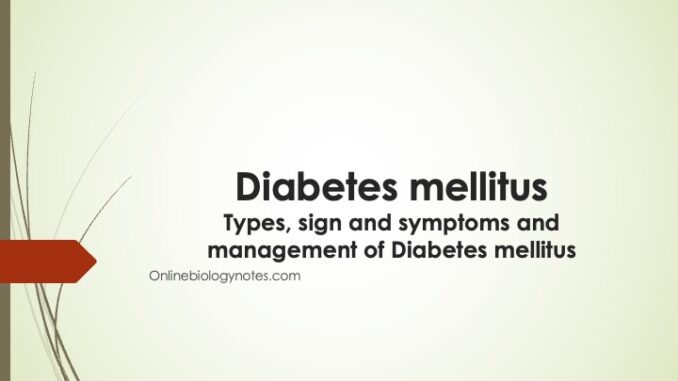
What is Diabetes mellitus?
- Diabetes mellitus is a chronic metabolic disorder characterized by hyperglycemia resulting from impaired insulin secretion
Classification of Diabetes
I. Type 1 Diabetes
- Insulin- dependent diabetes mellitus
- Juvenile- onset diabetes
Characteristics of Type I Diabetes
- Hypoinsulinemia
- 10% of diabetes case
- Patient require insulin
- Age onset is childhood
- Ketoacidosis
Etiology of Type I Diabetes
- Autoimmune disease
- Selective destruction of beta cells by T cells
- Several circulating antibodies against beta cells
- Cause of autoimmune attack
- Both genetic and environmental factor are important
II. Type 2 Diabetes
- Non- insulin- dependent diabetes mellitus
Adult- onset diabetes
Characteristics of Type 2 Diabetes
- Impaired insulin action
- Insulin secretion is normal or increased
- 90% 0f diabetes cases
- Age of onset is adulthood
- Associated with obesity
- Ketoacidosis but rare
- Most cases don’t require insulin
Etiology of Type 2 Diabetes
- Response to insulin is decreased
- The mechanism of insulin resistance is unclear
- Both genetic and environmental factor are responsible
- Post insulin receptor defect
Mechanism of hyperglycemia in diabetes
-
Increase in hepatic glucose output
- Decrease insulin secretion in Liver
- Decrease homeostatic effect on glucagon secretion resulting in increased glucagon
- Gluconeogenesis and glycogenolysis occurs in Liver
- Results in increased plasma glucose
2. Decrease in uptake of glucose in Muscles
- Decrease in insulin in muscles
- Decreased uptake of glucose and amino-acids in muscles
- Increased breakdown of proteins
- Results in increased plasma glucose and plasma amino acids
3. Decrease in uptake of glucose in adipose tissue
- Decrease in insulin
- Increased lipolysis and decreased lipogenesis
- Results in increased plasma fatty acids
Sign and symptoms of Diabetes
- thirst and frequent drinking
- most frequent urination particularly at night
- unexplained weight loss
- fatigue
- blurred vision
- frequent infection of skin, genital
Diagnostic evaluation of Diabetes
- history taking
- physical examination
- symptoms + random plasma glucose > 11.1 Mm (200mg/ dl )
- fasting plasma glucose >7Mm (126mg/dl)
- oral glucose tolerance test (OGTT) 2 hour plasma glucose >11.1Mm (200mg/dl)
Management of Diabetes mellitus
1. Medical management of Diabetes
Type 1 Diabets
- insulin injection should be given as per needed by analyzing blood sugar level
- frequent blood sugar check
- carbohydrate counting should be done
Type 2 Diabetes
- 7,5 % monotherapy ( metformin unless contraindicated)
- 5 – 9,0% dual therapy ( metformin + other medication)
- If the patient have diabetic complication then we must go for insulin therapy
- As Metformin is contraindicated in-case of renal failure, liver, or lung disease
2. Surgical management of Diabetes
- Gastric bypass and biliopancreatic diversion
- Pancreatic transplantation
- Islet cell transplantation
3. Nursing management of Diabetes
-
Nursing assessment of Diabetes A
- History taking, history of family and past medical history
- Past surgical history and other treatment
- Information about medication and insulin therapy
- Assessment of nutritional status
- Assess the blood sugar level
- Assess for sign and symptoms
2. Nursing diagnosis of Diabetes
- Imbalanced nutrition less than body requirement related to reduction of carbohydrate metabolism due to insulin deficiency
- Fluid volume deficit related to polyuria, decreased fluid intake
- Impaired skin integrity related to decreased sensory sensation, impaired circulation
- Risk for infection related to high glucose level reduction in leukocyte function
- Deficit knowledge about the disease the process related to lack of information
3. Nursing intervention of Diabetes
- Monitor vitals sign of the patient
- Provide medication as per cardex , administer insulin or an oral anti diabetic drug
- Analysis blood glucose level
- Maintain fluid and electrolyte balance
- Increase knowledge about diabetes management
- Monitoring and managing potential cmplications
- Provide skin care especially to the feet and legs
- Assist the client for coping mechanism
- Teach patient self- care and about disease condition
Complications of Diabetes mellitus
1. Acute complications of Diabetes
- Glucosuria ( glucose appear in urine)
- Polyuria( frequent urination)
- Polydipsia( excessive thirst)
- Polyphagia(excessive food intake)
- Ketoacidosis
2. Chronic complications of Diabetes
- Neuropathy ( loss of sensation due to damage of nerve fibres )
- Retinopathy ( damage of retina)
- Cataract ( damage of lens)
- In cardiovascular there may be atherosclerosis, hypertension, myocardial infraction
- In nephropathy there may be severe kidney failure and follow- up proteinuria
